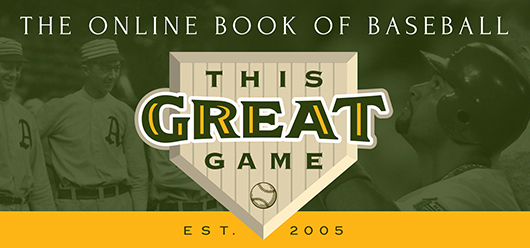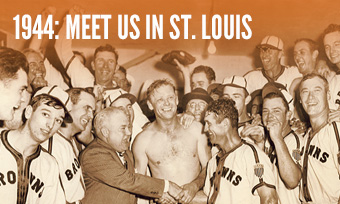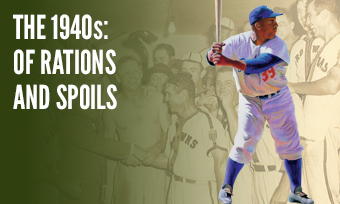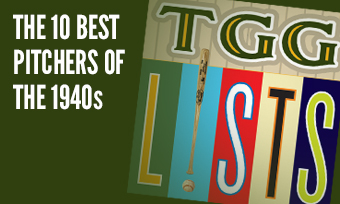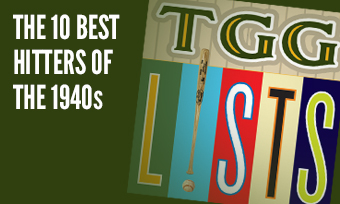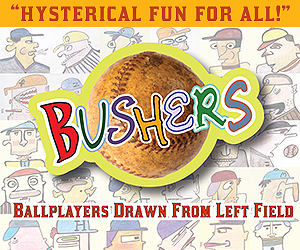The Yearly Reader
Leaders and Honors, 1944
Our list of baseball’s top 10 hitters and pitchers in both the American League and National League for the 1944 baseball season, as well as the awards and honors given to the game’s top achievers of the year.
The National League’s Top 10 Hitters, 1944
Bold type in brick red indicates league leader.
1. Stan Musial, St. Louis
Key Numbers: .347 average, 112 runs, 197 hits, 51 doubles, 14 triples, 12 home runs, 94 RBIs, 90 walks, .440 on-base percentage, .549 slugging percentage.
Musial kept his power to a minimum—his 12 homers were the fewest he ever hit outside of his rookie year—but continued overall maximum damage on pitchers.
2. Bill Nicholson, Chicago
Key Numbers: .287 average, 116 runs, 35 doubles, 8 triples, 33 home runs, 122 RBIs, 93 walks, 27 intentional walks.
Nicholson became the only player outside of Mike Schmidt and Nolan Arenado to lead the NL in both homers and RBIs over consecutive seasons.
3. Dixie Walker, Brooklyn
Key Numbers: .357 average, 77 runs, 191 hits, 37 doubles, 8 triples, 13 home runs, 91 RBIs, 72 walks.
A myriad of past injuries from head to toe made Walker ineligible for military service, but quite eligible for the NL batting title.
4. Augie Galan, Brooklyn
Key Numbers: .318 average, 96 runs, 174 hits, 43 doubles, 9 triples, 12 home runs, 93 RBIs, 101 walks.
All but given up for dead five years earlier from a broken knee and a slow recovery back to form, Galan capped a gradual comeback to pre-injury form in Brooklyn.
5. Johnny Hopp, St. Louis
Key Numbers: 139 games, .336 average, 106 runs, 177 hits, 35 doubles, 9 triples, 11 home runs, 72 RBIs, 15 stolen bases.
The center fielder became a premier wartime threat after five seasons of part-time play; he would prove his worthiness when baseball returned to full strength after the war.
6. Mel Ott, New York
Key Numbers: 120 games, .288 average, 91 runs, 26 home runs, 82 RBIs, 90 walks.
The 35-year-old slugger did not appear in 35 games and still finished a safe second in the NL home run race.
7. Bob Elliott, Pittsburgh
Key Numbers: .297 average, 85 runs, 28 doubles, 16 triples, 10 home runs, 108 RBIs, 75 walks, 10 caught stealing.
Elliott reached double-digits in home runs for the only time in eight years playing for the Pirates, before constantly racking up 20-ish dingers for the Braves later in his career at the less capacious Braves Field.
8. Phil Cavarretta, Chicago
Key Numbers: .321 average, 106 runs, 197 hits, 35 doubles, 15 triples, 5 home runs, 82 RBIs, 67 walks.
The trusty Cub’s wartime star continued to shine as he led the NL in hits and scored 100 times for the only time in his 22-year career.
9. Jim Russell, Pittsburgh
Key Numbers: .312 average, 109 runs, 181 hits, 34 doubles, 14 triples, 8 home runs, 66 RBIs, 79 walks.
The further along the season got, the better Russell hit; he averaged .231 through June and .366 after.
10. Johnny Barrett, Pittsburgh
Key Numbers: .269 average, 99 runs, 24 doubles, 19 triples, 7 home runs, 83 RBIs, 86 walks, 28 stolen bases.
The National League version of Snuffy Stirnweiss, Barrett was tops or near on all the speed-related stats (runs, triples, steals) in a short tenure enhanced by the lack of quality around him.
The American League’s Top 10 Hitters, 1944
1. Bob Johnson, Boston
Key Numbers: .324 average, 106 runs, 170 hits, 40 doubles, 8 triples, 17 home runs, 106 RBIs, 95 walks, .431 on-base percentage.
The growing lack of opposing talent helped give Johnson a bump back to the top at age 38; he even hit for the cycle for the only time in his career.
2. Snuffy Stirnweiss, New York
Key Numbers: .319 average, 643 at-bats, 125 runs, 205 hits, 35 doubles, 16 triples, 8 home runs, 43 RBIs, 73 walks, 55 stolen bases.
Allergies are what kept Stirnweiss from being swooped up by the military, and they’re also what made him one of the AL’s premier hitters for the duration of the war.
3. Stan Spence, Washington
Key Numbers: .316 average, 83 runs, 187 hits, 31 doubles, 8 triples, 18 home runs, 100 RBIs.
Echoing Goose Goslin from earlier times, spacious Griffith Stadium likely robbed Spence of a home run title as 16 of his 18 taters came on the road.
4. Bobby Doerr, Boston
Key Numbers: 125 games, .325 average, 95 runs, 152 hits, 30 doubles, 10 triples, 15 home runs, 81 RBIs, .528 slugging percentage.
When the MVP threat was snatched away by the military at the start of September, decent hopes of a pennant for the Red Sox—already handicapped with the drafting of ace pitcher Tex Hughson a month earlier—quickly faded.
5. Vern Stephens, St. Louis
Key Numbers: .293 average, 91 runs, 164 hits, 32 doubles, 20 home runs, 109 RBIs.
The military must have had a very high threshold for accepting healthy men into the ranks—the only way to explain their denial of Stephens, a true (and young, at 23) talent who was deferred due to a knee issue.
6. Johnny Lindell, New York
Key Numbers: .300 average, 91 runs, 178 hits, 33 doubles, 16 triples, 18 home runs, 103 RBIs.
Keeping center field warm for Army-owned Joe DiMaggio, Lindell amassed enough triples to tie Stirnweiss for the league lead—but also became one of just two Yankees to ever hit four doubles in a game.
7. Nick Etten, New York
Key Numbers: .293 average, 88 runs, 168 hits, 25 doubles, 22 home runs, 91 RBIs, 97 walks, 18 intentional walks.
Strike-shortened years omitted, Etten’s 22 homers were the fewest hit in the AL since the end of the Deadball Era; he hit seven in September alone just to get the season total that high.
8. Lou Boudreau, Cleveland
Key Numbers: .327 average, 91 runs, 191 hits, 45 doubles, 5 triples, 3 home runs, 67 RBIs, 73 walks, 11 stolen bases.
Already a defensive star with five straight years leading AL shortstops in fielding, Boudreau proved his worth at the plate by garnering the AL batting crown.
9. Roy Cullenbine, Cleveland
Key Numbers: .284 average, 98 runs, 162 hits, 34 doubles, 5 triples, 16 home runs, 80 RBIs, 87 walks.
On his sixth team in six years, Cullenbine finally began to find a footing that would stay solid (albeit briefly) even after the war.
10. Ken Keltner, Cleveland
Key Numbers: .295 average, 41 doubles, 9 triples, 13 home runs, 91 RBIs.
Bouncing back from a nasty spike wound the year before, Keltner returned to form with the Indians in his eighth season.
The National League’s Top 10 Pitchers, 1944
1. Bucky Walters, Cincinnati
Key Numbers: 2.40 ERA, 23 wins, 8 losses, .742 win percentage, 32 starts, 27 complete games, 6 shutouts, 285 innings.
It seemed like old times for Walters, who revived to the ace form he displayed in the Reds’ brief NL dynasty of 1939-40.
2. Mort Cooper, St. Louis
Key Numbers: 2.46 ERA, 22 wins, 7 losses, .759 win percentage, 33 starts, 7 shutouts, 252.1 innings.
Cooper verified his standing as the NL’s wartime ace—but somehow got passed up for the All-Star Game.
3. Max Lanier, St. Louis
Key Numbers: 2.65 ERA, 17 wins, 12 losses, 224.1 innings.
The southpaw’s career hit its acme before an induction into the military a year later—and, a year after that, an ill-fated move to the Mexican League.
4. Arnold Carter, Cincinnati
Key Numbers: 2.60 ERA, 11 wins, 7 losses, 33 appearances, 18 starts, 20 grounded into double plays.
Another pitcher who was around only because the ‘better’ arms were gone, Carter made the most of it for the Reds in his only full-time season at the top.
5. Bill Voiselle, New York
Key Numbers: 3.02 ERA, 21 wins, 16 losses, 43 appearances, 41 starts, 25 complete games, 312.2 innings, 118 walks, 161 strikeouts.
The workhorse of the year, after appearing in just six previous major league games, conceded 31 home runs; no other major leaguer gave up more than 18.
6. Ted Wilks, St. Louis
Key Numbers: 2.64 ERA, 17 wins, 4 losses, .810 win percentage, 36 appearances, 21 starts, 207.2 innings.
Wilks began the season ready to serve the military, then found out he was 4F—and rushed back to St. Louis where he became a rookie sensation for the Cardinals.
7. Ed Heusser, Cincinnati
Key Numbers: 2.38 ERA, 13 wins, 11 losses, 30 appearances, 23 starts, 192.2 innings, 42 walks.
A fringe player over the previous five years, bouncing back and forth between the majors and minors, the “Wild Elk of the Wasatch” grabbed an unlikely ERA title.
8. Rip Sewell, Pittsburgh
Key Numbers: 3.18 ERA, 21 wins, 12 losses, 38 appearances, 33 starts, 286 innings.
Sewell rode his famed, high-arcing “eephus” pitch to his second straight 21-win season.
9. Jim Tobin, Boston
Key Numbers: 3.01 ERA, 18 wins, 19 losses, 43 appearances, 36 starts, 28 complete games, 299.1 innings.
Burdened for years by a bad Braves team, Tobin took matters into his own hands—throwing a one-hitter in his second start, a no-hitter in his third, and a darkness-shortened five-inning no-no two months later. He still nearly lost 20 games.
10. Harry Brecheen, St. Louis
Key Numbers: 2.85 ERA, 16 wins, 5 losses, .762 win percentage, 30 appearances, 22 starts, 13 complete games, 189.1 innings.
Sticking around due to a malformed spine, the 31-year-old Brecheen was finally able to crack a rotation whittled apart by the war—and he would continue pitching exceptionally well after everyone came home.
The American League’s Top 10 Pitchers, 1944
1. Dizzy Trout, Detroit
Key Numbers: 2.12 ERA, 27 wins, 14 losses, 49 appearances, 40 starts, 33 complete games, 7 shutouts, 352.1 innings, 38 grounded into double plays.
With eyes too poor for the military but, clearly, still sharp enough for baseball, Trout was equally good against top teams (6-0 vs. the Yankees) and bad (one run allowed over 54.1 innings vs. the A’s).
2. Tex Hughson, Boston
Key Numbers: 2.26 ERA, 18 wins, 5 losses, .783 win percentage, 5 saves, 28 appearances, 23 starts, 203.1 innings, 41 walks.
Hughson easily would have won 20 games for the second time in three years had he not been sent packing to the military in early August; he picked up a save in every relief appearance he made.
3. Hal Newhouser, Detroit
Key Numbers: 2.22 ERA, 29 wins, 9 losses, .763 win percentage, 47 appearances, 34 starts, 25 complete games, 6 shutouts, 312.1 innings, 187 strikeouts.
The dominance of Newhouser and fellow Tiger Dizzy Trout were reflected in their 1-2 placement (with Newhouser at #1) in AL MVP voting.
4. Jack Kramer, St. Louis
Key Numbers: 2.49 ERA, 17 wins, 13 losses, 31 starts, 257 innings.
The New Orleans native’s season ERA was nearly half that of his 4.57 figure over his 11 other major league campaigns.
5. Nels Potter, St. Louis
Key Numbers: 2.83 ERA, 19 wins, 7 losses, .731 win percentage, 233 innings.
Out of the majors two years earlier after five rotten tries at it, Potter suddenly had the look of an A-list hurler against a diminished level of opposition. Perhaps a spitball was part of the reason; he was ejected for using one in a July game.
6. Steve Gromek, Cleveland
Key Numbers: 2.56 ERA, 10 wins, 9 losses, 35 appearances, 21 starts, 203.2 innings.
Signed five years earlier by the Indians as an infielding prospect, Gromek finally broke through on the mound.
7. Bobo Newsom, Philadelphia
Key Numbers: 2.82 ERA, 13 wins, 15 losses, 37 appearances, 33 starts, 265 innings.
Newsom managed to stay put in one city for a whole year and found his groove back, though it didn’t translate to a winning year with the lackluster A’s.
8. Hank Bowory, New York
Key Numbers: 2.64 ERA, 17 wins, 12 losses, 35 appearances, 30 starts, 252.2 innings.
The Yankees’ wartime ace authored his third straight sub-3.00 ERA in as many years since his major league arrival.
9. Johnny Niggeling, Washington
Key Numbers: 2.32 ERA, 10 wins, 8 losses, 24 starts, 206 innings.
The most efficient of four knuckleballers in the Senators’ rotation, sporting a career low ERA at age 41.
10. Joe Haynes, Chicago
Key Numbers: 2.57 ERA, 5 wins, 6 losses, 33 appearances, 12 starts, 154.1 innings.
Never mind the garden variety record; Haynes was in the neighborhood for a well-deserved ERA title. He’d actually get one in 1947, with everyone back.

